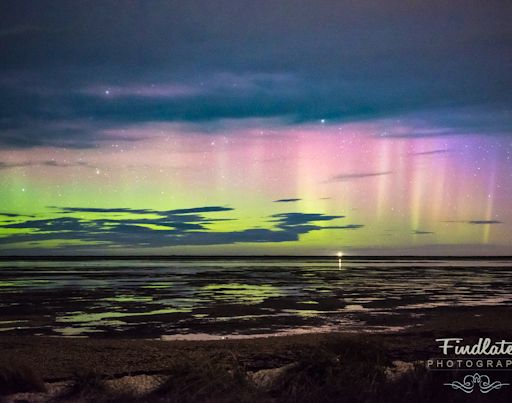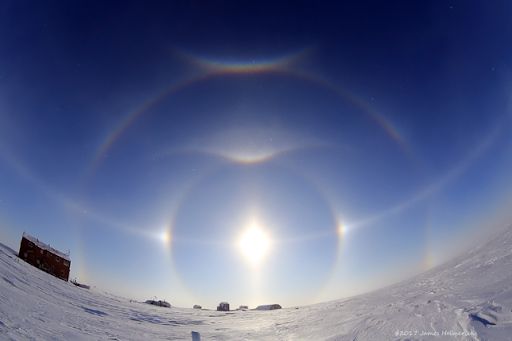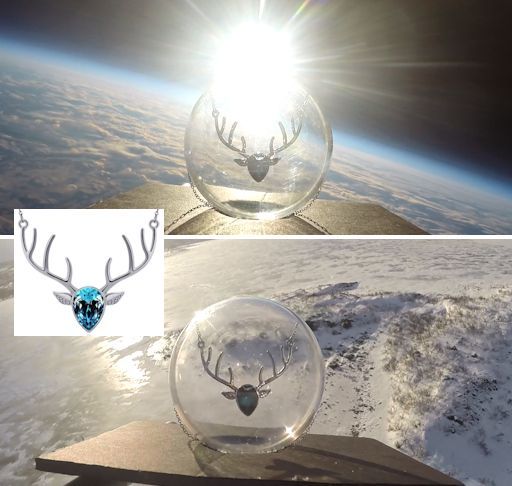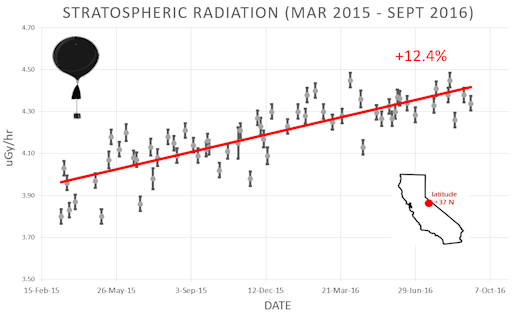Directly under the Arctic Circle! Marianne's Arctic Xpress in Tromsø offers fjord, whale and wildlife tours by day, aurora tours by night. Email Marianne for bookings and availability. | | | SUNSET SKY SHOW: When the sun goes down tonight, look west into the fading glow of sunset for an exquisitely slender crescent Moon. It forms a scalene triangle with Mars and Mercury on the edge of the constellation Pisces: sky map. SOLAR WIND STORM: For the 3rd consecutive day, our planet is inside a stream of fast-moving solar wind flowing from a canyon-shaped hole in the sun's atmosphere. The gaseous material is pressing against Earth's magnetic field with speeds exceeding 600 km/s. Earth's response: A light show around the poles. Last night, Layton Findlater saw the Southern Lights shining through clouds over Invercargill, New Zealand: 
"Another night of brief but intense auroras," says Findlater. "Hopefully, we can make it three nights running here in the Deep South."
At the moment, the solar wind shows little sign of flagging. Speeds between 600 and 700 km/s are likely for the rest of March 29th with a 25% chance of G1-class geomagnetic storms. High-latitude sky watchers on both ends of the planet should remain alert for auroras. Free: Aurora Alerts
Realtime Aurora Photo Gallery
'DIAMOND DUST' ICE HALOS: Northern Spring has arrived--but it is still cold above the Arctic Circle in Alaska. On March 27th, ice crystals filled the air of the Coleville River Delta on the state's north coast. When sunlight hit the glittering atmosphere, this is what happened: 
"An incredible network of ice halos surrounded the sun," says photographer James Helmericks. "It started around 12:30 pm with an ordinary 22 degree halo and some sundogs. As the sun sank lower into the afternoon sky, many other halos appeared, including a 360 degree parhelic circle, a bright circumzenithal arc, a 46 degree halo, and more." (Readers can go halo-hunting in this picture using a finder-chart from the South Pole.)
The variety and sharpness of this halo display is a sign that the sun was shining through "diamond dust"--jewel-like ice crystals of exceptional purity that form in cold polar environments. Indeed, a close look at Helmericks' picture shows specks of light in the air. Those are the glittering crystals of diamond dust which make these halos so beautiful. Realtime Space Weather Photo Gallery TOUCHING THE EDGE OF SPACE: On March 10, 2017, the students of Earth to Sky Calculus launched a space weather balloon from the frozen surface of Lake Tornetrask 250 km inside the Arctic Circle. A payload-full of reindeer pendants hitched a ride to the Edge of Space: 
You can have one for $129.95. Each glittering pendant comes with a greeting card showing the jewelry in flight and telling the story of its journey 97,000 feet above the Lapland of Northern Sweden. They make great Birthday and Mother's Day gifts. More far-out gifts may be found in the Earth to Sky store. All proceeds support STEM education and our atmospheric cosmic ray monitoring program.
Realtime Comet Photo Gallery
Realtime Venus Photo Gallery Every night, a network of NASA all-sky cameras scans the skies above the United States for meteoritic fireballs. Automated software maintained by NASA's Meteoroid Environment Office calculates their orbits, velocity, penetration depth in Earth's atmosphere and many other characteristics. Daily results are presented here on Spaceweather.com. On Mar. 29, 2017, the network reported 7 fireballs.
(7 sporadics)  In this diagram of the inner solar system, all of the fireball orbits intersect at a single point--Earth. The orbits are color-coded by velocity, from slow (red) to fast (blue). [Larger image] [movies] Potentially Hazardous Asteroids ( PHAs) are space rocks larger than approximately 100m that can come closer to Earth than 0.05 AU. None of the known PHAs is on a collision course with our planet, although astronomers are finding new ones all the time. On March 29, 2017 there were 1781 potentially hazardous asteroids. Notes: LD means "Lunar Distance." 1 LD = 384,401 km, the distance between Earth and the Moon. 1 LD also equals 0.00256 AU. MAG is the visual magnitude of the asteroid on the date of closest approach. | | Cosmic Rays in the Atmosphere |
Readers, thank you for your patience while we continue to develop this new section of Spaceweather.com. We've been working to streamline our data reduction, allowing us to post results from balloon flights much more rapidly, and we have developed a new data product, shown here: 
This plot displays radiation measurements not only in the stratosphere, but also at aviation altitudes. Dose rates are expessed as multiples of sea level. For instance, we see that boarding a plane that flies at 25,000 feet exposes passengers to dose rates ~10x higher than sea level. At 40,000 feet, the multiplier is closer to 50x. These measurements are made by our usual cosmic ray payload as it passes through aviation altitudes en route to the stratosphere over California. What is this all about? Approximately once a week, Spaceweather.com and the students of Earth to Sky Calculus fly space weather balloons to the stratosphere over California. These balloons are equipped with radiation sensors that detect cosmic rays, a surprisingly "down to Earth" form of space weather. Cosmic rays can seed clouds, trigger lightning, and penetrate commercial airplanes. Furthermore, there are studies ( #1, #2, #3, #4) linking cosmic rays with cardiac arrhythmias and sudden cardiac death in the general population. Our latest measurements show that cosmic rays are intensifying, with an increase of more than 12% since 2015: 
Why are cosmic rays intensifying? The main reason is the sun. Solar storm clouds such as coronal mass ejections (CMEs) sweep aside cosmic rays when they pass by Earth. During Solar Maximum, CMEs are abundant and cosmic rays are held at bay. Now, however, the solar cycle is swinging toward Solar Minimum, allowing cosmic rays to return. Another reason could be the weakening of Earth's magnetic field, which helps protect us from deep-space radiation. The radiation sensors onboard our helium balloons detect X-rays and gamma-rays in the energy range 10 keV to 20 MeV. These energies span the range of medical X-ray machines and airport security scanners. The data points in the graph above correspond to the peak of the Reneger-Pfotzer maximum, which lies about 67,000 feet above central California. When cosmic rays crash into Earth's atmosphere, they produce a spray of secondary particles that is most intense at the entrance to the stratosphere. Physicists Eric Reneger and Georg Pfotzer discovered the maximum using balloons in the 1930s and it is what we are measuring today. | | The official U.S. government space weather bureau | | | The first place to look for information about sundogs, pillars, rainbows and related phenomena. | | | Researchers call it a "Hubble for the sun." SDO is the most advanced solar observatory ever. | | | 3D views of the sun from NASA's Solar and Terrestrial Relations Observatory | | | Realtime and archival images of the Sun from SOHO. | | | from the NOAA Space Environment Center | | | a proud supporter of science education and Spaceweather.com | | | fun to read, but should be taken with a grain of salt! Forecasts looking ahead more than a few days are often wrong. | | | from the NOAA Space Environment Center | | | the underlying science of space weather |  | Beautyz for top beauty products reviews and their buying guides |  | Reviews here can help you to pick up best memory foam mattresses. | | | These links help Spaceweather.com stay online. Thank you to our supporters! | | 
